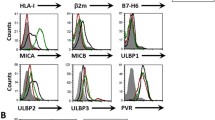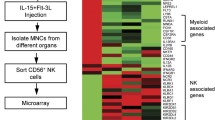Abstract
Human adult natural killer (NK) cells were recently demonstrated to inhibit herpes simplex virus (HSV) replicationin vitro. In this study we compared the ability of newborn and adult NK cells to inhibit HSV replication. Cord blood mononuclear cells (MNCs) from healthy, term newborns and MNCs from adults were analyzed for their percentage of Leu-11+ cells and comparedin vitro for their NK-cell activity against HSV-infected fibroblasts and the tumor cell line K562. Cord blood MNCs, compared with adult MNCs, had significantly lower percentages of Leu-11+ cells (5 vs 11%;P<0.01), less anti-K562 NK activity (6 vs 54 lytic units/107 cells;P<0.001), and less anti-HSV NK activity (5 vs 52% HSV plaque inhibition;P<0.02). Comparing individual neonates and adults with equal percentages of Leu-11+ cells, neonatal MNCs still had less NK activity against either target. When Leu-11+ MNCs were isolated using the fluorescence-activated cell sorter, neonatal Leu-11+ MNCs still inhibited HSV replication less than adult Leu-11+ MNCs (P<0.01). MNCs from some neonates had significant anti-K562 NK activity but poor anti-HSV NK activity, suggesting either nonidentical NK-cell subpopulations or specific suppression. Whereas neonatal NK activity against K562 was always augmented by prior exposure to either interferon (IFN) or interleukin-2 (IL-2), the neonatal NK activity against HSV-infected cells was only augmented for half of the neonates tested. Endogenous production of alpha-IFN and gamma-IFN by MNCs exposed to HSV-infected fibroblasts was the same for cells from neonates or from HSV-seronegative adults. More gamma-IFN was produced by MNCs from HSV-seropositive adults than from neonates or HSV-seronegative adults. These results suggest that although newborns have phenotypically identifiable NK cells and the capacity for IFN production, the ability of the NK cells to inhibit HSV replication is impaired, and their level of response and augmentation by specific lymphokines is target specific.
Similar content being viewed by others
References
Pass RF, Stagno S, Myers GJ, Alford CA: Outcome of asymptomatic congenital cytomegalovirus infections: Results of long-term follow up. Pediatrics 66:758, 1980
Visintine A, Nahmias A, Whitley R, Alford C: The natural history and epidemiology of neonatal herpes simplex virus infection.In The Human Herpesviruses, AJ Nahmias, WR Dowdle, RE Schinazi (eds) Elsevier, New York, 1981, p 599
Ching C, Lopez C: Natural killing of herpes simplex virus type I-infected target cells: Normal human responses and influence of antiviral antibody. Infect Immun 26:49–56, 1979
Lanier LL, Warner NL: Paraformaldehyde fixation of hematopoietic cells for quantitative flow cytometry (FACS) analysis. J Immunol Methods 47:25, 1981
Pross HF, Baines MG, Rubin P, Shragge P, Patterson MS: Spontaneous human lymphocyte-mediated cytotoxicity against tumor target cells. IX. The quantitation of natural killer cell activity. J Clin Immunol 1:51–63, 1981
Leibson PJ, Hunter-Laszlo M, Hayward AR: Inhibition of HSV-1 replication in fibroblast cultures by human blood mononuclear cells. J Virol 57:976–982, 1986
Kohl S: Neonatal herpes.In Neonatal Infections: Nutritional and Immunologic Interactions, PL Ogra (ed). Orlando, FL, Grune and Stratton, 1984, pp 147–158
Pass RF, Dworsky ME, Whitley RJ, August AM, Stagno S, Alford CA: Specific lymphocyte blastogenic responses in children with cytomegalovirus and herpes simplex virus infections acquired early in infancy. Infect Immun 34:166–170, 1984
Hayward AR, Herberger MJ, Groothuis J, Levin MR: Specific immunity after congenital or neonatal infection with cytomegalovirus or herpes simplex virus. J Immunol 133:2469–2473, 1984
Yeager AS, Arvin AM, Urbani LJ, Kemp JA III: Relationship of antibody to outcome in neonatal herpes simplex virus infections. Infect Immun 29:532–538, 1980
Shore SL, Milgrom H, Wood PA, Nahmias AJ: Antibody-dependent cellular cytotoxicity to target cells infected with herpes simplex viruses: Functional adequacy in the neonate. Pediatrics 59:22–28, 1977
Kohl S, Frazier JJ, Greenberg SB, Pickering LK, Loo LS: Interferon induction of natural killer cytotoxicity in human neonates. J Pediat 98:379–384, 1981
Mintz L, Drew WL, Hoo R, Finley TN: Age-dependent resistance of human alveolar macrophages to herpes simplex virus. Infect Immun 28:417–420, 1980
Timonen T, Saksela E: Human natural cell-mediated cytotoxicity against fetal fibroblasts. I. General characteristics of the cytotoxic activity. Cell Immunol 33:340–352, 1977
Sato T, Fuse A, Kuwata T: Enhancement by interferon of natural cytotoxic activities of lymphocytes from human cord blood and peripheral blood of aged persons. Cell Immunol 45:458–463, 1979
Antonelli P, Stewart W II, Dupont B: Distribution of natural killer cell activity in peripheral blood, cord blood, thymus, lymph nodes, and spleen and the effect ofin vitro treatment with interferon preparation. Clin Immunol Immunopathol 19:161–169, 1981
Kohl S, Shaban SS, Starr SE, Wood PA, Nahmias AJ: Human neonatal and maternal monocyte macrophage and lymphocyte-mediated antibody-dependent cytotoxicity to cells infected with herpes simplex. J Pediat 93:106–210, 1978
Lopez C, Kirkpatrick D, Read SE, Fitzgerald PA, Pitt J, Pahwa S, Ching CY, Smithwick EM: Correlation between low natural killing of fibroblasts infected with herpes simplex virus type I and susceptibility to herpesvirus infection. J Infect Dis 147:1030–1035, 1983
Fitzgerald PA, Mendolsohn M, Lopez C: Human natural killer cells limit replication of herpes simplex virus Type Iin vitro. J Immunol 134:2666–2672, 1985
Abo T, Cooper MD, Balch CM: Postnatal expansion of the natural killer and killer cell populations in humans identified by the monoclonal HNK-I antibody. J Exp Med 155:321–326, 1982
Lanier LL, Le AM, Phillips JH, Warner NL, Babcock GF: Subpopulations of human natural killer cells defined by expression of the Leu-7 (HNK-I) and Leu-11 antigens. J Immunol 131:1789–1796, 1983
Itoh K, Tilden AB, Kumagai K, Balch CM: Leu-11+ lymphocytes with natural killer activity are precursors of recombinant interleukin 2-induced activated killer cells. J Immunol 134:802–807, 1985
Lanier LL, Benike CJ, Phillips JH, Engleman EG: Recombinant interleukin 2 enhanced natural killer cell-mediated cytotoxicity in human lymphocyte subpopulations expressing the Leu7 and Leu-11 antigens. J Immunol 134:794–801, 1985
Abo T, Miller CA, Balch CM: Characterization of human granular lymphocyte subpopulations expressing HNK-1 (Leu-7) and Leu-11 antigens in the blood and lymphoid tissues from fetuses, neonates and adults. Eur J Immunol 14:616–623, 1984
Warner NL, Tai AS: Analysis of the differentiation lineage of NK cells. Fed Proc 40:2711–2716, 1981
Fitzgerald PA, Evans R, Kirkpatrick D, Lopez D: Heterogeneity of human NK cells: comparison of effectors that lyse HSV-1 infected fibroblasts and K562 erythroleukemia targets. J Immunol 130:1663–1667, 1983
Welsh RM: Natural killer cells and interferon. CRC Crit Rev Immunol 5:55–93, 1984
Timonen T, Ortaldo JR, Stadler BM, Bonnard GD, Sharrow S, Herberman RB: Cultures of purified human natural killer cells. Growth in the presence of IL-2. Cell Immunol 72:198, 1982
Trinchieri G, Matsumoto-Kobayashi M, Clark SC, Seehra J, London L, Perussia B: Response of resting human peripheral blood natural killer cells to interleukin 2. J Exp Med 160:1147–1169, 1984
Ueno Y, Miyawaki T, Seki H, Matsuda A, Taga K, Sato H, Taniguchi N: Differential effects of recombinant human gamma-interferon and interleukin 2 on natural killer cell activity of peripheral blood in early human development. J Immunol 135:180–184, 1985
Seki H, Ueno Y, Taga K, Matsuda A, Miyawaki T, Taniguchi N: Mode ofin vitro augmentation of natural killer cell activity by recombinant human interleukin 2: A comparative study of Leu-11+ and Leu-11− cell populations in cord blood and adult peripheral blood. J Immunol 135:2351–2356, 1985
Author information
Authors and Affiliations
Rights and permissions
About this article
Cite this article
Leibson, P.J., Hunter-Laszlo, M., Douvas, G.S. et al. Impaired neonatal natural killer-cell activity to herpes simplex virus: Decreased inhibition of viral replication and altered response to lymphokines. J Clin Immunol 6, 216–224 (1986). https://doi.org/10.1007/BF00918701
Accepted:
Issue Date:
DOI: https://doi.org/10.1007/BF00918701




